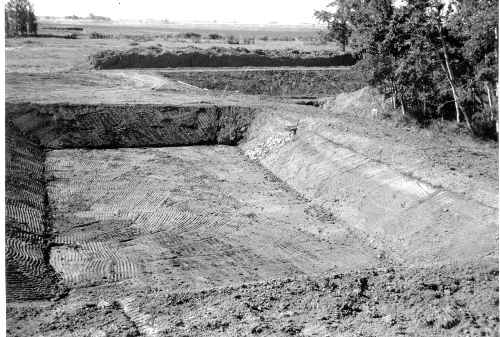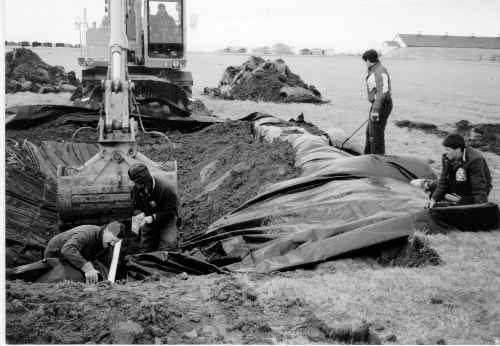| | Site selection| Size and capacity| Design and construction| Impervious lining| Dugout aeration| Dugout maintenance| Useful references
Dugouts provide water for a variety of purposes. They can be used as a source for domestic (household) water supplies, livestock watering, as well as raising fish for enjoyment or profit.
There are a few main points to consider when you have decided to construct a dugout that will contain fish:
- site selection
- dugout size
- construction methods
- other water uses
- aeration systems
- maintenance of the dugout
Site Selection
Before dugout construction begins, proper planning and design must take place. The intended dugout site should be thoroughly investigated. First, the location should be a safe distance from all possible contamination sources as shown in the following table. Excess nutrient loading from farmstead practices contributes to problem weed growth and fish die-off in dugouts.
| Table 1. Possible dugout contamination sources |
| Source of contamination | Distance from dugout in metres |
| Septic tank | 9 |
| Sewage disposal field | 15 |
| Corral | 15 |
| Sewage lagoon | 90 |
| Open discharge | 45 |
Local bylaws can affect where dugouts are to be constructed. Always check with your municipality on their regulations for dugout construction. Overhead and underground utility lines and right-of-ways could play a factor in the placement of the dugout. Always have the utilities located and marked before starting any construction.
Good wind exposure is a benefit, as it helps circulate water during the summer while keeping snow off in winter. Avoid coulee bottoms or ravines with little wind action. Although they ensure plentiful water supply through drainage and snow trapping, they tend to have problems with low oxygen levels, either from nutrient loading, excessive snowpack or toxic gas buildup from plant decomposition.
Be careful of slough or bog areas containing high organic matter, such as peat moss. Maintaining water quality is difficult in these areas.
Particular attention must be paid to the dugout's water source. Water can be obtained from four basic sources: direct precipitation, surface runoff, ground water or from another water body. If water quality is questionable, samples should be submitted to a lab and the results reviewed by a fish biologist.
Surface runoff, originates from snow melt and rainfall. Because water drains from fields and livestock operations, the watershed needs to be checked for activities that contaminate the runoff. If, at any time, the water quality is questionable, then the addition of berms around the dugout and the installation of a water diversion will help.
Groundwater is another source of water used to fill dugouts. This water is naturally available only in high water table areas. Fluctuations of the ground water table should be monitored over a 12-month period, prior to construction. This monitoring helps you decide whether water levels will be adequate to keep the dugout filled year-round.
Filling from another water source is the fourth water option. Water may be obtained from other dugouts, lakes, wells, canals or rivers. If this option is chosen, consider distance, topography, land cover (i.e. bush roads, etc.) and land ownership between source and dugout prior to construction.1
If the dugout is located near a creek or stream, it should be located off the main channel. A corrugated metal pipe with a control gate on the end should be installed to control water flow into the dugout. This allows the operator to avoid receiving poor quality water.
In all cases, sample the soil at least 1 meter below the proposed dugout floor to determine soil type and moisture content. Soil conditions will dictate what equipment is required to construct the dugout, what material will be used for an impermeable barrier and whether the dugout should be constructed at all.
Size and Capacity
Correct dugout sizing is very important to ensure an adequate water supply for years to come. The dugout should store enough water to last for two years, the typical limits of a severe drought cycle. There may be other demands on a pond's water supply besides raising fish. The following table provides approximate guidelines for water usage.
| Table 2. Water usage guidelines |
| Daily Requirements | Litres Per Day |
| Human | 227 |
| Dairy cow | 136 |
| Beef/steer | 41 |
| Horse | 45 |
| Sheep | 14 |
Other water usage guidelines are listed in the Water Act application package published by Alberta Environment. The size of the dugout will determine the number of fish to stock, although other factors have a bearing. These factors include:
- amount of weed growth
- type of aeration
- water flow
- amount of natural fish food
- size of fish
The licenced Commercial Fish Farmer who sells you fingerlings will help determine an appropriate stocking rate for your dugout. Always start with low trout numbers in a new dugout or dugouts that have never held fish. A 50 metre by 20 metre dugout should be capable of stocking 100 trout in the 20 cm (8 inch) size. More information on fish stocking rates is available from Alberta Agriculture and Food.
Design and Construction
Any shape of dugout is acceptable for fish farming, although the simple rectangular shape is the most common (Figure 1). For fish culture, a minimum depth of 4 meters is recommended. If a shallow section is required, sloping the bottom of the dugout is the solution, with the deepest section being a minimum of 4 meters.

Figure 1. Typical dugout construction.
Side slopes are recommended to be not steeper than 1.5 to 1 on every side of the dugout. If unstable soil conditions are present or easy access is required (e.g. boat ramp), slopes may have to be flattened out to 1:4. The type of construction equipment used may also have a bearing on the steepness of the slopes. Shallow slopes are an open invitation to predacious birds such as great blue herons. As well, prolific weed growth is normal in dugouts or ponds with shallow shore edges.
Dugout costs will vary according to each site and its soil and moisture properties. The average cost for excavating, landscaping, and installing inlet control on a dugout of 50m x 20m x 5m deep (with a capacity of 2 million litres) is $4,000 to $7,000.
Make provisions for the installation of aeration systems, water intake and watering systems. Fence off the dugout to exclude livestock as they can damage the dugout's integrity by trampling, causing erosion or indirectly contributing to water quality problems. For more information on fencing for livestock, see Agdex 576-4 Managing Cow-Calf Operations to Protect Water Quality.
Be safe. Fences prohibit access to young children and may be necessary in some locations. Dugouts with aeration systems are especially dangerous in the winter as they usually cause unsafe or thin ice.
Impervious Lining
In some instances, you may chose to locate a dugout where the subsurface soil conditions are not capable of holding water (i.e. sand and fractured bed rock). In this case, lining the dugout with an impervious material may be the only option (Figure 2).

Figure 2. Installing and backfilling plastic liner.
Various types of lining materials are on the market. Presently, plastic lining (woven polyethylene) is most popular. Cover the liner with soil, free of rocks, to a depth of 0.4 - 0.5 meters.
Installing a liner in an area with high groundwater is not recommended. If the water table is higher than the water level inside the dugout, the liner will be pushed inward causing sloughing and eventual collapse of the sides.
Dugout Aeration
Many dugouts require aeration to improve water quality for domestic use, to increase dissolved oxygen in the dugout for fish and to reduce the likelihood of muddy-tasting fish. Air flows of 1.7m3/hour (1 ft3/min) are usually sufficient to aerate an average-sized dugout of 2,700,000 litres (600,000 imperial gallons).
Basically, two types of air pumping devices can be installed in a dugout: wind mills or electrically-powered air compressors. For fish culture, electrically-powered air compressors are recommended over wind mills as they allow uninterrupted dugout aeration. The initial cost of an air compressor is around $400, increasing with pump size. Annual electricity costs range between $50 and $100 when using a typical air compressor with 1/8 to 1/4 HP electric motor.
The compressor should be oil-less and of a diaphragm type. Compressor suppliers should be able to help you select the proper pump. Before seeing a dealer, obtain the basic information about your dugout, such as depth, length and width. Depth is especially important for sizing a compressor. Only the most recent measurements should be used.
Once air is pumped into the dugout, it should be distributed by a linear or point diffuser located on or close to the bottom. This method ensures efficient circulation of water and uniformity of dissolved oxygen. Inexpensive air stones can be purchased at most farm supply stores.
Dugout Maintenance
If the dugout is constructed properly and in a suitable location, very little maintenance is required. If algae, vegetation or suspended solids become problems, then control can be either chemical (copper sulphate, diquat, aluminum sulphate, etc.), mechanical (uprooting weeds with chains) or biological (grass carp). Care must be taken in dugouts used for fish culture, as some of the chemical applications are directly toxic to the fish or result in decomposing plants that ultimately deplete the oxygen needed by the fish.
Useful References
Quality Farm Dugouts, Agdex 716 (B01) is available from Alberta Agriculture and Forestry:
Publications Office
7000 - 113 Street
Edmonton, Alberta T6H 5T6
Phone toll-free: 1-800-292-5697 or
visit: www.agric.gov.ab.ca/publications
If you require assistance, please contact:
Dan Watson
Alberta Agriculture and Forestry
Agriculture Centre
100, 5401 - 1st Avenue S.
Lethbridge, Alberta T1J 4V6
Phone: (403) 381-5850
Fax: (403) 381-5903
1 When diverting or discharging water, a permit may be required from Alberta Environment, Water Management Division, Licencing and Permitting Standards Branch.
Source: Agdex 485/716-1. Revised February 2005. |
|